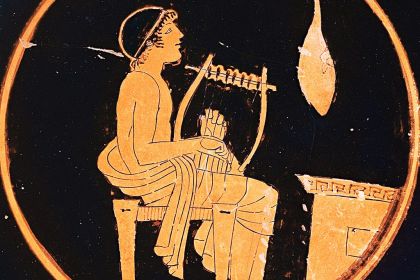Music Theory
Popular songs featuring Phrygian mode and Neapolitan chord

Orpheus in a Phrygian cap by Giovanni Dall'Orto
Musical Mode: Phrygian Mode
Western music theory describes seven diatonic scales that are the basis of corresponding musical modes, among which the major and minor still dominate due to the universality of their harmonic structure. Other seven-note scales such as Phrygian, Lydian, Dorian, and Mixolydian have the status of modal modes and used mainly to create a musical atmosphere specific to a particular geographical area, historical period, or to evoke associations with various folk cultures.
Of all the modal modes, the Phrygian minor is probably the most widespread in classical music which is evident from a number of works completely composed in the Phrygian mode. In folk and popular genres, some Phrygian elements are often interpolated into corresponding minor or other musical modes.
In comparison with the natural minor, the Phrygian scale has only one but a quite significant alteration of the second scale degree—called the supertonic—which is lowered and differs from the tonic by a semitone.
C Phrygian scale:

The flatted supertonic puts the focus on the major chord rooted in that second scale degree which is known as the Neapolitan chord and is often used for musical cadences in both the Phrygian and Aeolian minor modes. Another result of this alteration touches the dominant triad: it is turned into a diminished chord and thus becomes unsuitable for the performance in the most important authentic cadence.

The flatted supertonic puts the focus on the major chord rooted in that second scale degree which is known as the Neapolitan chord and is often used for musical cadences in both the Phrygian and Aeolian minor modes. Another result of this alteration touches the dominant triad: it is turned into a diminished chord and thus becomes unsuitable for the performance in the most important authentic cadence.
A vivid example of the Neapolitan chord can be heard in the intro of the iconic song Space Oddity, the opening track of David Bowie's second studio album. The harmonic analysis of the song's chord chain denotes scale degrees with Roman numerals, showing the following progressions:
- Fmaj7–Em–Fmaj7–Em or II7–i–II7–i for the intro
- C–Em–C–Em–A–D7 or VI–i–VI–i–IV–VII7 for the pre-verse
In the intro, the Fmaj7 Neapolitan seventh chord alternates with the E minor tonic triad but the further chord progression is not possible in the Phrygian mode since the major chords rooted in the fourth and seventh scales would have to be minor to fit with the Phrygish canon.
Listen to Space Oddity by David Bowie:
The jazz composition Warm Canto, recorded by saxophonist Booker Ervin and pianist Mal Waldron for 1962 The Quest, is based on the developed Phrygian harmony with the following core chord sequences:
- Em–C–Fmaj7–Dm7 or i–VI–II7–vii7
- Em–C–F–Dm or i–VI–II–vii
- Em–Dm7–Cmaj7–Bm or i–vii7–VI7–v
- Am7 or iv7
In the first two lines, the musical functions follow in an order that has been considered to be the cornerstone of classical music canon for centuries: T-S-D-T or tonic-subdominant-dominant-tonic. Moreover, the chord sequence II–vii–i is often performed as a cadence in the Phrygian mode.
Lines three and four show the progression in which chords are built on each consecutive degree of the Phrygian scale in descending order, bookended by the plagal cadence with the A minor subdominant seventh chord. In this chord chain, the only chord belonging to the natural minor is the B minor dominant triad which can't be expressed in the Phrygian mode without being diminished.
Listen to Warm Canto by Booker Ervin & Mal Waldron:
Another curious example of the Phrygian mode is shown in New Person, Same Old Mistakes released by the Australian psychedelic pop musician Tame Impala in his 2015 Currents album. Indeed, verses and choruses of the song are arranged entirely with two Phrygian sequences:
- Cm–D♭–A♭–Cm or i–II–VI–i
- Cm–E♭–D♭–A♭–Cm or i–III–II–VI–i
In these progressions, the D♭ Neapolitan chord transitions into the C minor tonic chord through a classy resolution in the form of the Ab submediant triad rooted in the Phrygian sixth scale degree.
Listen to New Person, Same Old Mistakes by Tame Impala:
I Care, recorded by Beyoncé in 2011 for her fourth studio album, is a rare case of a popular song based entirely on the Phrygian progressions of the following chords:
- C–Em–C–Em or VI–i–VI–i
- Em–G–F–Em–F–Em or i–III–II–i–II–i
- F–G–F–Em–F–Em–F or II–III–II–i–II–i–II
As in the above-mentioned David Bowie song, the F major Neapolitan chord appears here preceding the E minor tonic triad, a combination that is the most characteristic sign of the Phrygian mode.
Listen to I Care by Beyoncé:
Surely, the Phrygian mode as a diatonic scale belongs not only in Western music since the other world cultures also contain its analogs.
The Phrygian scale—called the Bayati maqam—appears in the Maqam melodic system of Arabic, Persian and Turkish classical music, and in Indian classical music there is Bhairavi thaat which is completely equivalent to the modern Phrygian scale. Although these musical systems do not imply chords and polyphonic structures, the melodies performed in the Phrygian or other scales deliver a unique feeling, and in this way, all music modes themselves can be compared with different paints of the artist’s palette.
Discover more songs composed in Phrygian minor mode and check out their harmonic analysis in the following articles:
- No Quarter: two minor modal modes of Led Zeppelin's psychedelic track
- Burbujas de Amor: playful and saucy lyrics by Juan Luis Guerra
- Things We Said Today: the only Beatles song featuring Phrygian mode



